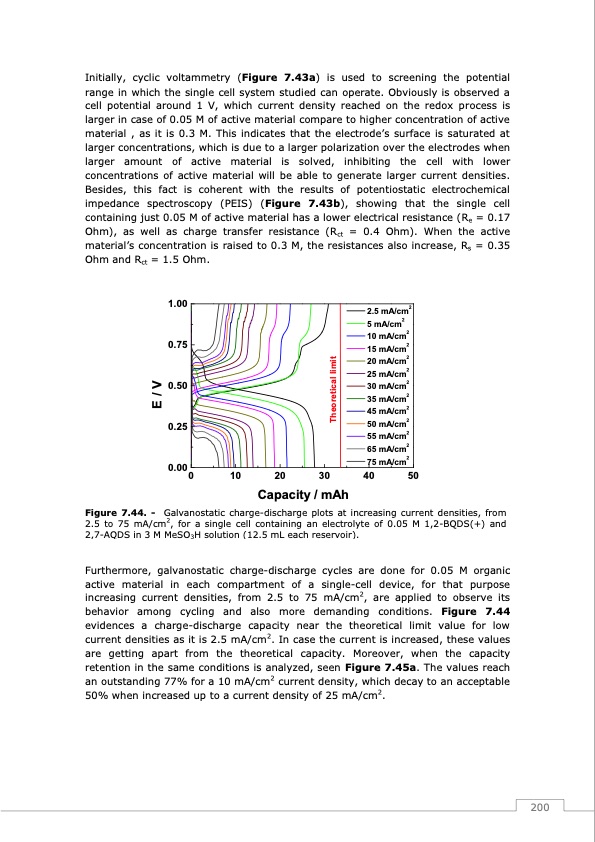
PDF Publication Title:
Text from PDF Page: 201
Initially, cyclic voltammetry (Figure 7.43a) is used to screening the potential range in which the single cell system studied can operate. Obviously is observed a cell potential around 1 V, which current density reached on the redox process is larger in case of 0.05 M of active material compare to higher concentration of active material , as it is 0.3 M. This indicates that the electrode’s surface is saturated at larger concentrations, which is due to a larger polarization over the electrodes when larger amount of active material is solved, inhibiting the cell with lower concentrations of active material will be able to generate larger current densities. Besides, this fact is coherent with the results of potentiostatic electrochemical impedance spectroscopy (PEIS) (Figure 7.43b), showing that the single cell containing just 0.05 M of active material has a lower electrical resistance (Re = 0.17 Ohm), as well as charge transfer resistance (Rct = 0.4 Ohm). When the active material’s concentration is raised to 0.3 M, the resistances also increase, Rs = 0.35 Ohm and Rct = 1.5 Ohm. 1.00 0.75 2.5 mA/cm2 5 mA/cm2 10 mA/cm2 15 mA/cm2 20 mA/cm2 25 mA/cm2 E/V Theoretical limit 0.50 30 mA/cm2 0.25 35 mA/cm2 45 mA/cm2 50 mA/cm2 55 mA/cm2 65 mA/cm2 0.00 75 mA/cm2 0 10 20 30 40 50 Capacity / mAh Figure 7.44. - Galvanostatic charge-discharge plots at increasing current densities, from 2.5 to 75 mA/cm2, for a single cell containing an electrolyte of 0.05 M 1,2-BQDS(+) and 2,7-AQDS in 3 M MeSO3H solution (12.5 mL each reservoir). Furthermore, galvanostatic charge-discharge cycles are done for 0.05 M organic active material in each compartment of a single-cell device, for that purpose increasing current densities, from 2.5 to 75 mA/cm2, are applied to observe its behavior among cycling and also more demanding conditions. Figure 7.44 evidences a charge-discharge capacity near the theoretical limit value for low current densities as it is 2.5 mA/cm2. In case the current is increased, these values are getting apart from the theoretical capacity. Moreover, when the capacity retention in the same conditions is analyzed, seen Figure 7.45a. The values reach an outstanding 77% for a 10 mA/cm2 current density, which decay to an acceptable 50% when increased up to a current density of 25 mA/cm2. 200PDF Image | Redox Flow Batteries Vanadium to Earth Quinones

PDF Search Title:
Redox Flow Batteries Vanadium to Earth QuinonesOriginal File Name Searched:
FJVG_TESIS.pdfDIY PDF Search: Google It | Yahoo | Bing
Salgenx Redox Flow Battery Technology: Salt water flow battery technology with low cost and great energy density that can be used for power storage and thermal storage. Let us de-risk your production using our license. Our aqueous flow battery is less cost than Tesla Megapack and available faster. Redox flow battery. No membrane needed like with Vanadium, or Bromine. Salgenx flow battery
| CONTACT TEL: 608-238-6001 Email: greg@salgenx.com | RSS | AMP |